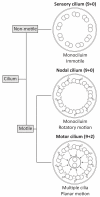Picking up speed: advances in the genetics of primary ciliary dyskinesia
- PMID: 24192704
- PMCID: PMC3946436
- DOI: 10.1038/pr.2013.200
Picking up speed: advances in the genetics of primary ciliary dyskinesia
Abstract
Abnormal ciliary axonemal structure and function are linked to the growing class of genetic disorders collectively known as ciliopathies, and our understanding of the complex genetics and functional phenotypes of these conditions has rapidly expanded. While progress in genetics and biology has uncovered numerous cilia-related syndromes, primary ciliary dyskinesia (PCD) remains the sole genetic disorder of motile cilia dysfunction. The first disease-causing mutation was described just 13 y ago, and since that time, the pace of gene discovery has quickened. These mutations separate into genes that encode axonemal motor proteins, structural and regulatory elements, and cytoplasmic proteins that are involved in assembly and preassembly of ciliary elements. These findings have yielded novel insights into the processes involved in ciliary assembly, structure, and function, which will allow us to better understand the clinical manifestations of PCD. Moreover, advances in techniques for genetic screening and sequencing are improving diagnostic approaches. In this article, we will describe the structure, function, and emerging genetics of respiratory cilia, review the genotype-phenotype relationships of motor ciliopathies, and explore the implications of recent discoveries for diagnostic testing for PCD.
Figures
Comment in
-
Response to Snijders et al.Pediatr Res. 2014 Sep;76(3):322. doi: 10.1038/pr.2014.80. Epub 2014 Jun 16. Pediatr Res. 2014. PMID: 24933009 No abstract available.
-
Nasal NO, high-speed video microscopy, electron microscopy, and genetics: a primary ciliary dyskinesia puzzle to complete.Pediatr Res. 2014 Sep;76(3):321. doi: 10.1038/pr.2014.79. Epub 2014 Jun 16. Pediatr Res. 2014. PMID: 24933010 No abstract available.
References
-
- Afzelius BA. A human syndrome caused by immotile cilia. Science. 1976;193:317–9. - PubMed
-
- Eliasson R, Mossberg B, Camner P, Afzelius BA. The immotile-cilia syndrome. A congenital ciliary abnormality as an etiologic factor in chronic airway infections and male sterility. N Engl J Med. 1977;297:1–6. - PubMed
-
- Fliegauf M, Benzing T, Omran H. When cilia go bad: cilia defects and ciliopathies. Nat Rev Mol Cell Biol. 2007;8:880–93. - PubMed
-
- Pedersen LB, Rosenbaum JL. Intraflagellar transport (IFT) role in ciliary assembly, resorption and signalling. Curr Top Dev Biol. 2008;85:23–61. - PubMed
Publication types
MeSH terms
Grants and funding
LinkOut - more resources
Full Text Sources
Other Literature Sources
Medical



